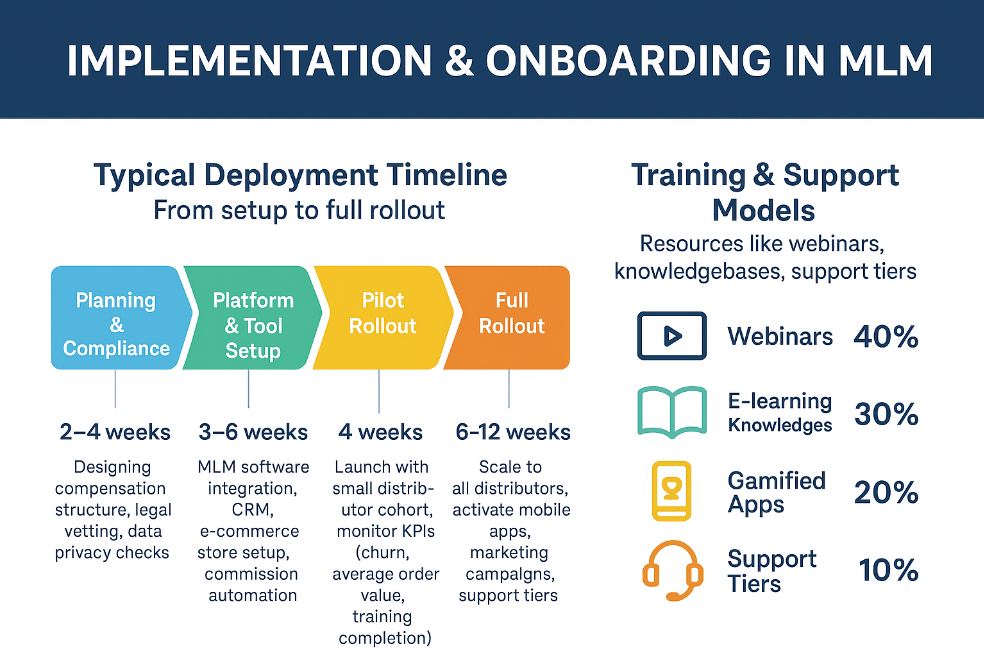

The MLM industry is set to reach $239.8 billion by 2028, a growth fueled by wellness, personal care, and digital products.
This rapid expansion hinges on effective implementation and onboarding, which are crucial for ensuring distributors can quickly sell, recruit, and succeed.
This article dives into the essential strategies behind a successful launch, covering both the typical deployment timeline and the vital training and support models
needed to build a robust and compliant ecosystem.
The multi-level marketing (MLM) industry continues to evolve rapidly, shaped by digital transformation, regulatory oversight, and shifting distributor expectations.
Yet, successful scaling depends heavily on implementation and onboarding strategies, ensuring distributors are quickly empowered to sell, recruit, and thrive within a compliant ecosystem.
This article explores two vital aspects:
I will also highlight benchmarks, current trends (2023–2025), and best practices backed by recent research and reports.
Launching an MLM platform involves far more than distributing starter kits. It requires synchronized planning across technology, compliance, compensation models, and training infrastructure.
Research indicates that poor onboarding or rushed rollout leads to 20–40% distributor attrition within the first 90 days (FTC Fellowship Report, 2024).
| Phase | Activities | Timeframe | Benchmarks / Proofs |
|---|---|---|---|
| Planning & Compliance | Designing compensation structure, legal vetting, data privacy checks | 2–4 weeks | FTC oversight highlights misaligned pay plans as top compliance issue (FTC, 2024) |
| Platform & Tool Setup | MLM software integration, CRM, e-commerce store setup, commission automation | 3–6 weeks | IT operating model studies show staggered IT onboarding reduces system crashes (Suleman et al., 2024) |
| Pilot Rollout | Launch with small distributor cohort, monitor KPIs (churn, average order value, training completion) | 4 weeks | Staggered onboarding improves adoption and retention (Chen et al., 2024) |
| Full Rollout | Scale to all distributors, activate mobile apps, marketing campaigns, support tiers | 6–12 weeks | Firms using phased rollout had 25% higher retention (Berryman, 2024) |

Distributor success is tied directly to training effectiveness. Studies highlight that distributors who attend at least one webinar per week generate
40% higher sales compared to those relying solely on printed materials (Chen et al., 2024).
Let’s represent a standard deployment timeline from setup to rollout.
The chart shows that a full MLM implementation may take 16–26 weeks, depending on complexity, IT infrastructure, and regulatory review. Companies that skip pilot rollouts often face system downtime, payment disputes, and compliance penalties (Dasaklis et al., 2025).
Q1. What is the typical timeline for implementing MLM software?
Most MLM implementations take 16–26 weeks, moving through planning, platform setup, pilot rollout, and full deployment. The exact timeline depends on compliance reviews, IT complexity, and distributor readiness.
Q2. Why is onboarding important in MLM?
Onboarding ensures distributors understand compensation plans, compliance, and sales tools. Companies with structured onboarding see 20–40% lower distributor attrition in the first 90 days.
Q3. What are the best training methods for MLM distributors?
The most effective models include webinars, interactive e-learning, gamified mobile apps, and tiered support. Webinars alone can increase distributor sales performance by 40%.
Q4. How do support tiers work in MLM onboarding?
Tiered support ranges from automated chatbots (basic FAQs), to regional managers (hands-on coaching), to compliance/legal escalation. This structure reduces support backlogs and improves distributor satisfaction.
Q5. What are the current trends in MLM onboarding (2023–2025)?
Key trends include digital-first platforms, AI-powered training, multilingual onboarding, compliance automation, and community-driven learning hubs.
Implementation and onboarding in MLM are no longer about delivering starter kits and brochures. They require careful phased deployment with compliance-first planning, followed by robust training ecosystems that blend webinars, knowledge bases, gamification, and tiered support.
The industry trend is clear: digital-first, compliance-secure, AI-assisted training will define MLM growth between 2025–2030. Firms that invest in thoughtful onboarding strategies see not only higher distributor retention but also stronger brand credibility in a competitive market.
Also Read in Detail –